-
Aviso de importancia, Reglamento del Foro actualizado. Reglas Técnicas, punto Q. Ir al siguiente link: Ver aviso
Estás usando un navegador obsoleto. No se pueden mostrar estos u otros sitios web correctamente.
Se debe actualizar o usar un navegador alternativo.
Se debe actualizar o usar un navegador alternativo.
FIDAE 2006: Todas las novedades y noticias
- Tema iniciado Nesher
- Fecha de inicio
Les dejo algunas novedades de Jane's.
FIDAE 2006: Chile set to buy US KC-135 tanker aircraft
Jose Higuera JDW Correspondent
Chile
Date Posted: 31-Mar-2006
The US government has received an official request from Chile for the sale of "up to three KC-135 tanker aircraft", sources close to the Chilean Air Force in Santiago confirmed to Jane's.
The tail boom-equipped tanker aircraft are needed to support new and second-hand F-16s being acquired from the US and the Netherlands. The Chilean air force currently operates a single Boeing 707 modified for the role and equipped with drogue and hose refuelling equipment.
Boeing's Integrated Defense Systems Assistant Manager, Earl Godby, confirmed the existence of government- to-government negotiations between Washington and Santiago. So far, the US has confirmed that two KC-135s are available for sale to Chile, he added.
The US government is currently forming its price offer for a Foreign Military Sales contract. The offer is expected to be submitted to Santiago in April or early May.
In the meantime, a Chilean Air Force technical delegation is set to visit the facility in Arizona where the retired KC-135s are held in storage.
Godby told Jane's that the KC-135s could be delivered to Chile within the next five months after the deal is signed and that the tanker aircraft will be fully overhauled in the US before delivery. He also confirmed that Boeing has reached an agreement with Chile's ENAER aerospace company to support the local maintenance of the KC-135s.
FIDAE 2006: Santiago revives helicopter acquisition plan
Jose Higuera JDW Correspondent
Chile
Date Posted: 31-Mar-2006
* Buoyed by soaring copper prices, Chile wants to buy 70 additional helicopters
* A combination of new, upgraded and second-hand aircraft may be procured
Chile has reactivated long-standing plans to acquire about 70 new and used military helicopters as soaring international copper prices are expected to feed a USD1 billion surplus into the nation's defence procurement accounts by the end of 2006.
It was decided to re-start the helicopter acquisition after previous plans to buy a single, standard rotary wing aircraft for the armed forces and the Carabineros national police were dropped.
The Army's Comando de Aviación del Ejército is looking to buy around 40 helicopters to replace its SA-330L Puma and AS-332 Super Puma battlefield transport helicopters, as well as around 20 MD 530F armed reconnaissance helicopters currently in service and a number of SA-315 Lamas retired in recent years.
The options for the Puma/Super Puma replacement include newly built Eurocopter NH90s and Mil Mi-17s, as well as second-hand Sikorsky UH-60A Black Hawks from US Army surplus stocks. Alternatives to replace the MD 530Fs and the SA-315 Lamas range from the Bell AH-1Z Viper, the Eurocopter Tiger and the AgustaWestland A129 Mangusta. Bell is also going to run with its 407 armed reconnaissance helicopter, which has been selected by the US Army.
The Chilean Navy's Comando de Aviación Naval plans to replace its remaining fleet of five, shipborne, Exocet-armed AS-532 Super Puma helicopters - known as Cougars - as well as around 10 ageing Bell UH-57 and BO-105 training and utility helicopters.
The NH90 is considered the natural and preferred option to replace the navy's Super Pumas, with second-hand Sikorsky SH-60 Seahawks running close behind as a cheaper alternative.
AgustaWestland is set to enter the competition with its EH101, proposing it for operation on board the UK-built Type 22 frigate Williams and the three newer Type 23 frigates. In total, the navy needs between eight and 10 helicopters equipped with maritime attack mission systems and weapons for shipboard deployment.
The Chilean Navy has started to address the need for new light utility helicopters by purchasing three refurbished Eurocopter HH-65 Dauphins worth USD10 million. Another five refurbished Dauphins equipped with observation and rescue equipment could be purchased.
Navy plans to buy new training helicopters are being kept on hold, pending the assessment of the results of a pilot plan to settle a joint flight training system and school with the air force.
The Chilean Air Force needs to renew its fleet of around 20 Bell UH-1H Iroquois helicopters. The first option being considered is to buy a new machine similar to the European NH90. Alternative solutions include the acquisition of additional Sikorsky UH-60As.
A third alternative, which could be used in combination with a Black Hawk fleet, is to refurbish the Bell UH-1Hs using the life extension and modernisation package offered by Bell Textron. The package, shown at the FIDAE 2006 air show in the form of an upgraded Argentine Army machine, includes an upgrade to the Lycoming T53L engine. The load lifting capability of the helicopters has been increased by nearly 300 kg and they now have greater endurance. Operational costs have been lowered by 42 per cent.
The air force also has a requirement to buy a small number of light utility and liaison helicopters, which could be fulfilled by India's HAL Dhruv.
FIDAE 2006: Mexican Navy looks to advanced jets
Jose Higuera JDW Correspondent
Chile
Date Posted: 31-Mar-2006
The Mexican Navy is setting a higher target for its acquisition of combat jets, looking to advanced alternatives like the Saab JAS-39 Gripen and Sukhoi Su-27, Mexican sources have told Jane's.
According to the sources, the navy's initial aspirations to acquire a batch of the Czech Aero Vodochody L-159 subsonic training and light strike aircraft have been superseded, as the service looks for more capable, advanced and expensive combat jets.
To that purpose, a navy delegation recently visited Sweden for a presentation of the Gripen multirole fighter. Delegations are also set to visit Russia in order to receive presentations and to test the MiG-29 and Su-27.
It is intended that the combat aircraft will support anti-drug and anti-smuggling operations in the Gulf of Mexico. The service acquired three Northrop Grumman E-2C Hawkeye Airborne Early Warning and Command (AEW&C) aircraft from Israel between 2003 and 2004 to increase the surveillance of maritime and air traffic in the area.
As the navy's surveillance capabilities increased, the need for fast jet combat aircraft to perform interdiction tasks against drug-carrying vessels and aircraft became more evident.
The Mexican Air Force cannot be relied on to perform interdiction tasks because of the limited status of its fleet of Northrop F-5E Tiger IIs. Also, there is an almost complete lack of a joint operations doctrine inside Mexico's armed forces. The fact that both services acquired separate airborne early warning assets in the form of a single EMB-145 and the E-2Cs reflects this.
M
MIGUEL
Che...!!!, en español...¿ nada de nada?
Atte.-
Miguel
Atte.-
Miguel
MIGUEL dijo:Che...!!!, en español...¿ nada de nada?
Atte.-
Miguel
La primera nota dice que Chile va a comprar "hasta tres KC-135". Por ahora EEUU confirmó que 2 están disponibles para su venta a Chile y actualmente están armando el contrato FMS. También Boeing llegó a un acuerdo para que el mantenimiento de los KC-135 se haga en ENAER.
La segunda es sobre la reactivación del programa de adquisición de helicópteros para las FFAA chilenas. Están interesadas en hasta 70 unidades nuevas y usadas. Para el ejército se habla de 40 helicópteros. El reemplazo de los Pumas/Super Pumas, podrían ser Eurocopter NH90s, Mil Mi-17s y Sikorsky UH-60A Black Hawks. Para reemplazar a los MD 530Fs y los SA-315 Lamas, las alternativas van desde el Bell AH-1Z Viper, el Eurocopter Tiger y el AgustaWestland A129 Mangusta. Bell también va a participar con su helicoptero de reconocimiento armado 407.
La armada va a reemplazar sus 5 AS-532 Super Puma y 10 UH-57 y BO-105.
El NH-90 es el candidato natural para reemplazar los Super Pumas, pero también está la alternativa más barata de SH-60 Seahawks usados.
AgustaWestland está proponiendo al EH101 para operación a bordo de las nuevas Type 23 y la Type 22. La fuerza aérea, tiene que reemplazar a 20 Bell UH-1H, las alternativas son comprar algo similar al Eurocopter NH-90, más UH-60As o una modernización a Huey II.
La tercera es sobre la armada mexicana que está pensando adquirir JAS-39 Gripen o Su-27, en vez de los Aero Vodochody L-159 que habían previsto originalmente.
M
Mavericko
que envidia sana que les tengo a los chilenos loco...
la verdad que solo les deseo una cosa, por el bien de todos: no se envicien! ajjajajaja
la verdad que solo les deseo una cosa, por el bien de todos: no se envicien! ajjajajaja
hay matriculas de los aviones en venta?

saludos

saludos
hay algun uav hecho en chile que este en fidae?
Aviadoranonimo
Forista Sancionado o Expulsado
Yo tampoco las veo 
Saludos

Saludos
Yo tampoco las veo Jose , buena noticia para Chile , se necesitan esos tanker para los 28 Vipers , y mejor si acuerdo para un tercero , la alargan tremendamente las patas , en especial a los Block 50
Un general chileno piloteó un avión de guerra argentino
El jefe de la Fuerza Aérea del vecino país condujo un “IA-63Pampa” tras la invitación de las autoridades argentinas en la FIDAE 2006, una feria castrense internacional que se realiza en Santiago
El jefe de la Fuerza Aérea de Chile, general Osvaldo Sarabia, en un hecho inédito en esa institución, pilotó ayer un avión de guerra de su similar argentina, como parte de las actividades de la Feria Internacional del Aire y del Espacio (FIDAE), que se celebra en Santiago.
Sarabia se subió a un avión "IA-63 Pampa", tras aceptar la invitación que le formuló la Fuerza Aérea Argentina.
En el viaje hasta Rancagua, unos 80 kilómetros al sur de Santiago, fue acompañado por el primer teniente de la Fuerza Aérea del país vecino, Sergio Brole.
El general Sarabia dijo que se trató de "una experiencia fantástica" y elogió las características de la aeronave argentina.
El "Pampa" es un avión de entrenamiento básico táctico avanzado "de muy buenas características, tiene economía, tecnología, se siente bien, no es difícil de volar", subrayó el general chileno.
El teniente Brole, en conversación con la prensa local, indicó que sólo encendió el motor del avión, y que el jefe de la aviación chilena pilotó todo el trayecto.
El "Pampa" es un cazabombardero utilizado por la Fuerza Aérea de Argentina para el entrenamiento de sus pilotos de combate, alcanza una velocidad máxima de 819 kilómetros por hora y tiene una autonomía de 720 kilómetros.
La invitación de la Fuerza Aérea Argentina al comandante en jefe de la Fuerza Aérea chilena "es una demostración evidente de las buenas relaciones existentes entre ambos países e instituciones", estimaron algunos analistas militares presentes en la muestra.
Fuente: Infobae
Con la billetera generosa de la FACh en una de esas...
El jefe de la Fuerza Aérea del vecino país condujo un “IA-63Pampa” tras la invitación de las autoridades argentinas en la FIDAE 2006, una feria castrense internacional que se realiza en Santiago
El jefe de la Fuerza Aérea de Chile, general Osvaldo Sarabia, en un hecho inédito en esa institución, pilotó ayer un avión de guerra de su similar argentina, como parte de las actividades de la Feria Internacional del Aire y del Espacio (FIDAE), que se celebra en Santiago.
Sarabia se subió a un avión "IA-63 Pampa", tras aceptar la invitación que le formuló la Fuerza Aérea Argentina.
En el viaje hasta Rancagua, unos 80 kilómetros al sur de Santiago, fue acompañado por el primer teniente de la Fuerza Aérea del país vecino, Sergio Brole.
El general Sarabia dijo que se trató de "una experiencia fantástica" y elogió las características de la aeronave argentina.
El "Pampa" es un avión de entrenamiento básico táctico avanzado "de muy buenas características, tiene economía, tecnología, se siente bien, no es difícil de volar", subrayó el general chileno.
El teniente Brole, en conversación con la prensa local, indicó que sólo encendió el motor del avión, y que el jefe de la aviación chilena pilotó todo el trayecto.
El "Pampa" es un cazabombardero utilizado por la Fuerza Aérea de Argentina para el entrenamiento de sus pilotos de combate, alcanza una velocidad máxima de 819 kilómetros por hora y tiene una autonomía de 720 kilómetros.
La invitación de la Fuerza Aérea Argentina al comandante en jefe de la Fuerza Aérea chilena "es una demostración evidente de las buenas relaciones existentes entre ambos países e instituciones", estimaron algunos analistas militares presentes en la muestra.
Fuente: Infobae
Con la billetera generosa de la FACh en una de esas...
PythonV
Colaborador
Amigos, y...llego el final de la fiesta, vengo llegando muy cansado pues hubo unos atochamientos enormes a la salida del aeropuerto ,casi dos horas solo para salir a la autopista
Haré un breve reporte por ahora, pues debo revisar mas de 1500 fotografias que tomé en la semana para asi compartir con ustedes las mejores.
Les dejo algunas imagenes de hoy, dia de clausura.
El publico general repletó el recinto el dia de hoy, aqui se puede ver el interes por ver el interior de este VC-10 Tanker
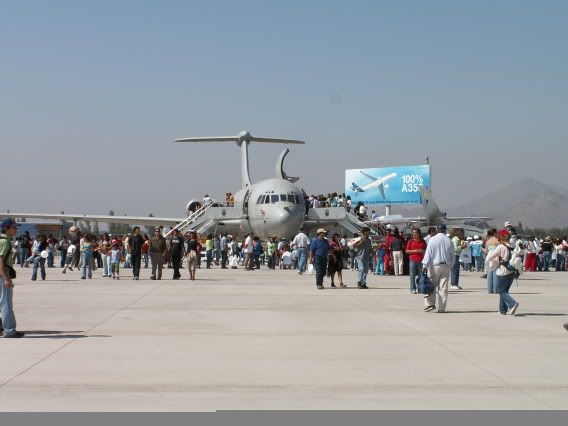
El B-1B pasa a baja altura sobre nosotros.
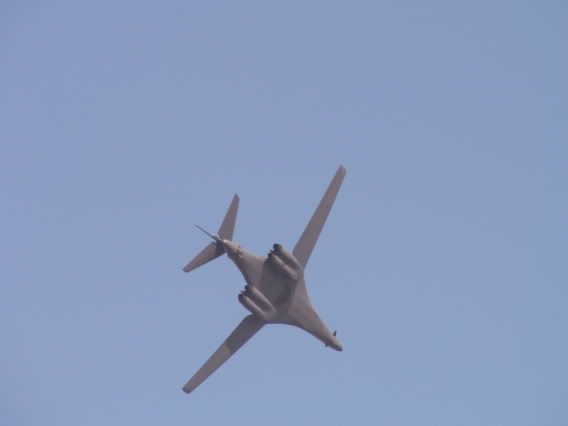
Su tripulacion se aleja caminando del avion una vez terminado el vuelo.
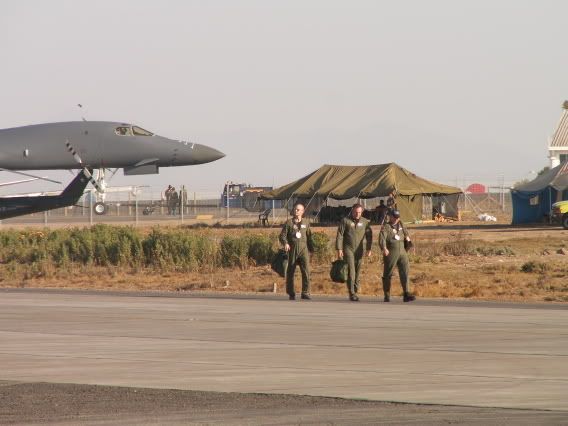
Los brits se relajan ya al final de la tarde
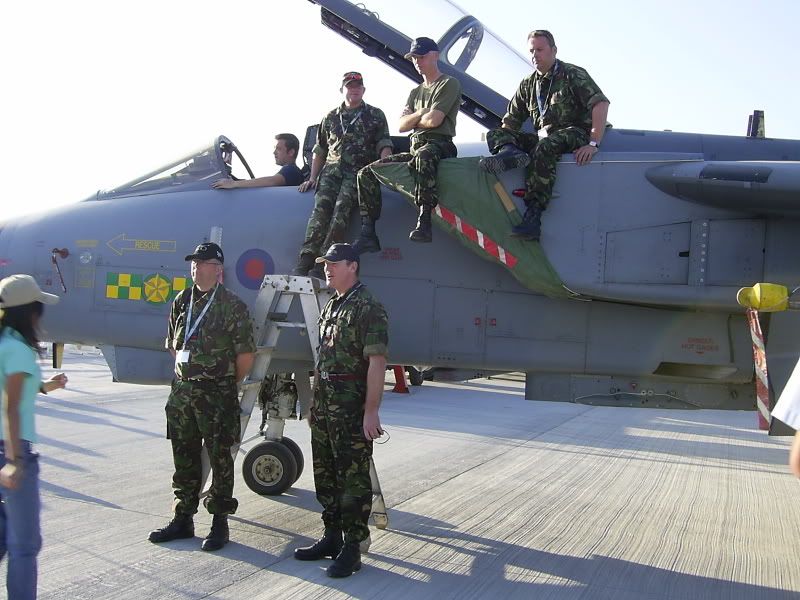
Un Eagle terminando su espectacular demostración.
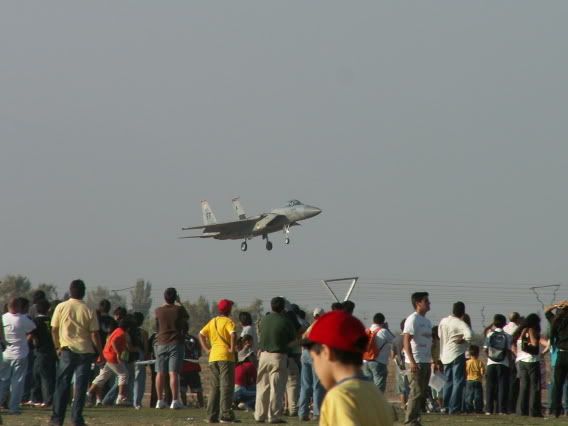
Los cuatro perros bravos de la FACH...
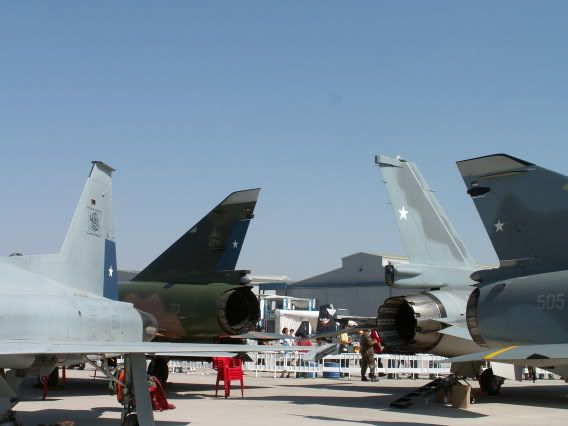
Hace tiempo que no veia a la ranita hacer tan buen show como lo hizo hoy, aqui se le ve regresando a la linea de vuelo tras su presentación
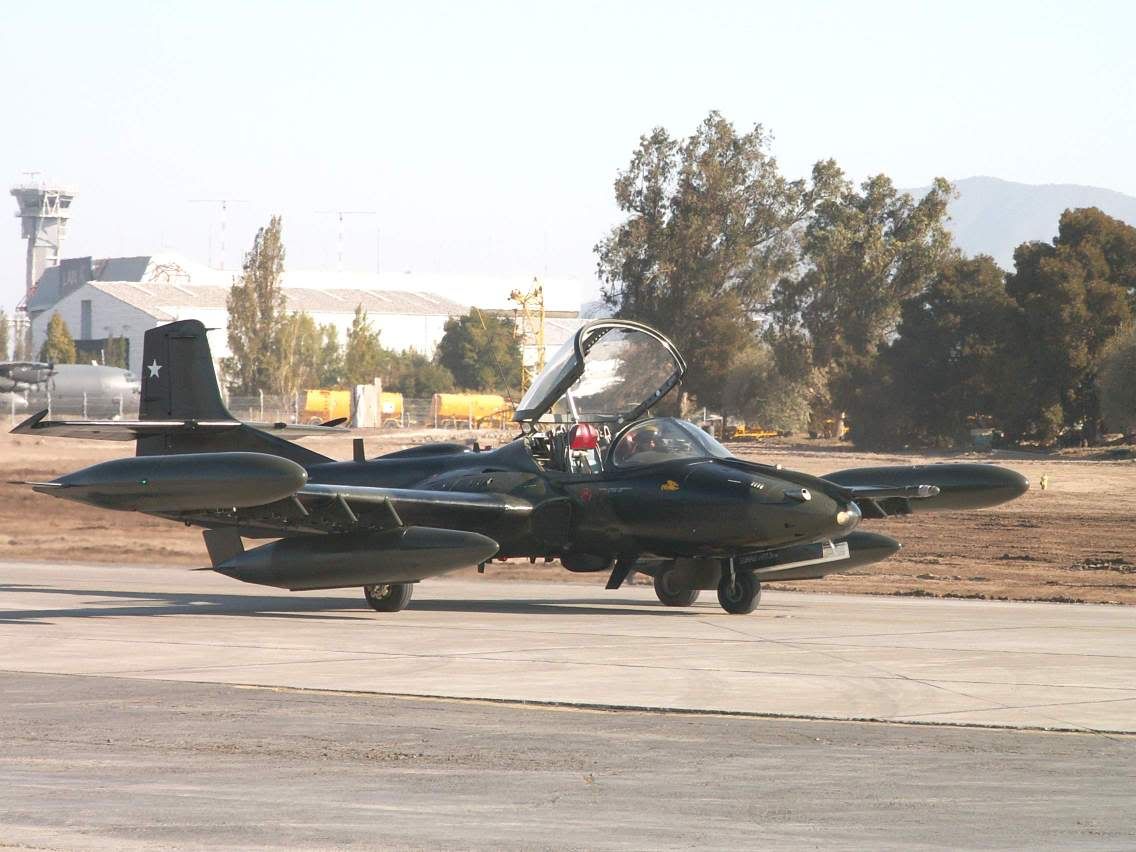
Un UH-1 despega llevando fotografos a mirar la feria desde arriba (yo pude conseguir el mismo vuelo la FIDAE anterior) realmente vale la pena.
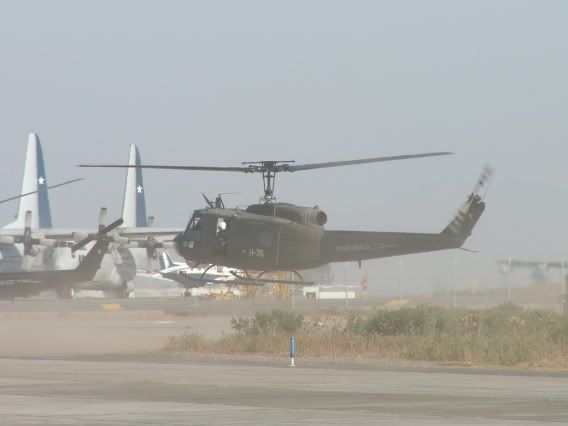
Por ser dia de gran afluencia de publico, los que pusieron puestos de souvenirs estaban mas que sonrientes
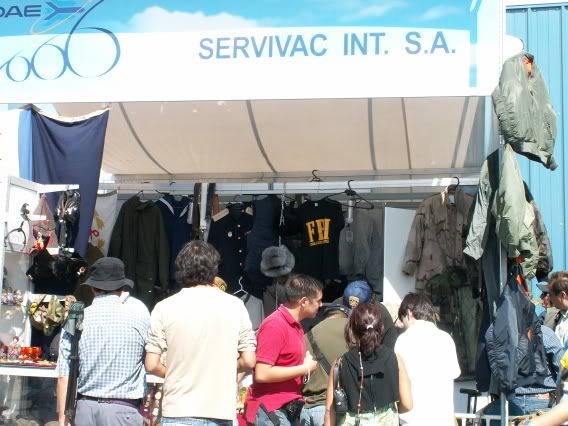
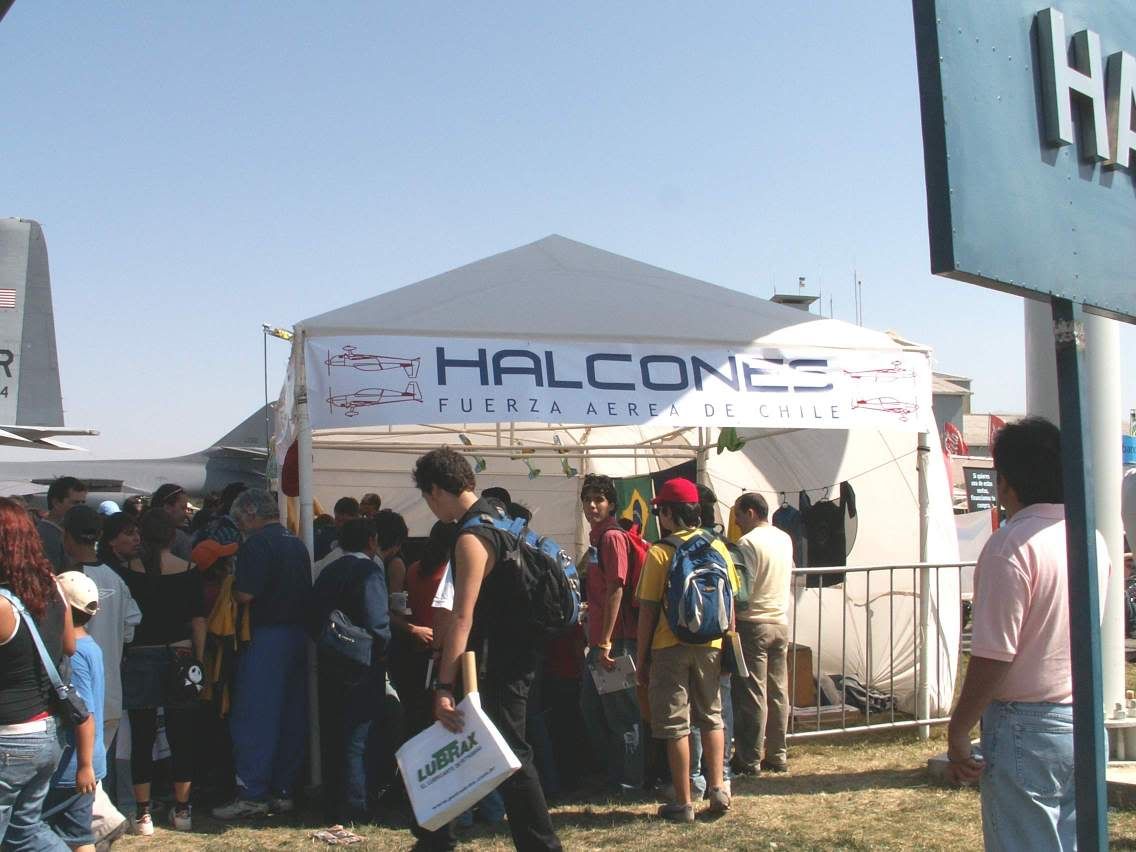
El ultimo show del ultimo dia , como es costumbre, estuvo a cargo de los "Halcones" quienes una vez en tierra procedieron a la tradicional ceremonia de cambio de lider.
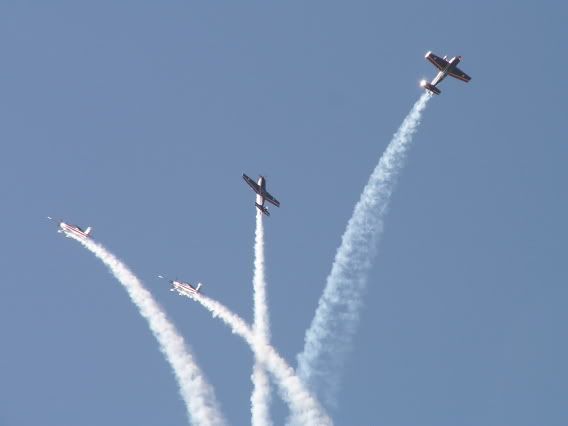
Las chicas lindas del dia de hoy:
Este angelito de la empresa Gildemeister...

Y esta linda dama que preguntaba algo sobre un avion

La expresion de este aviador de la FACH lo dice todo , mientras muestra la cabina de un T-35 Pillan a esta señorita...
, mientras muestra la cabina de un T-35 Pillan a esta señorita...
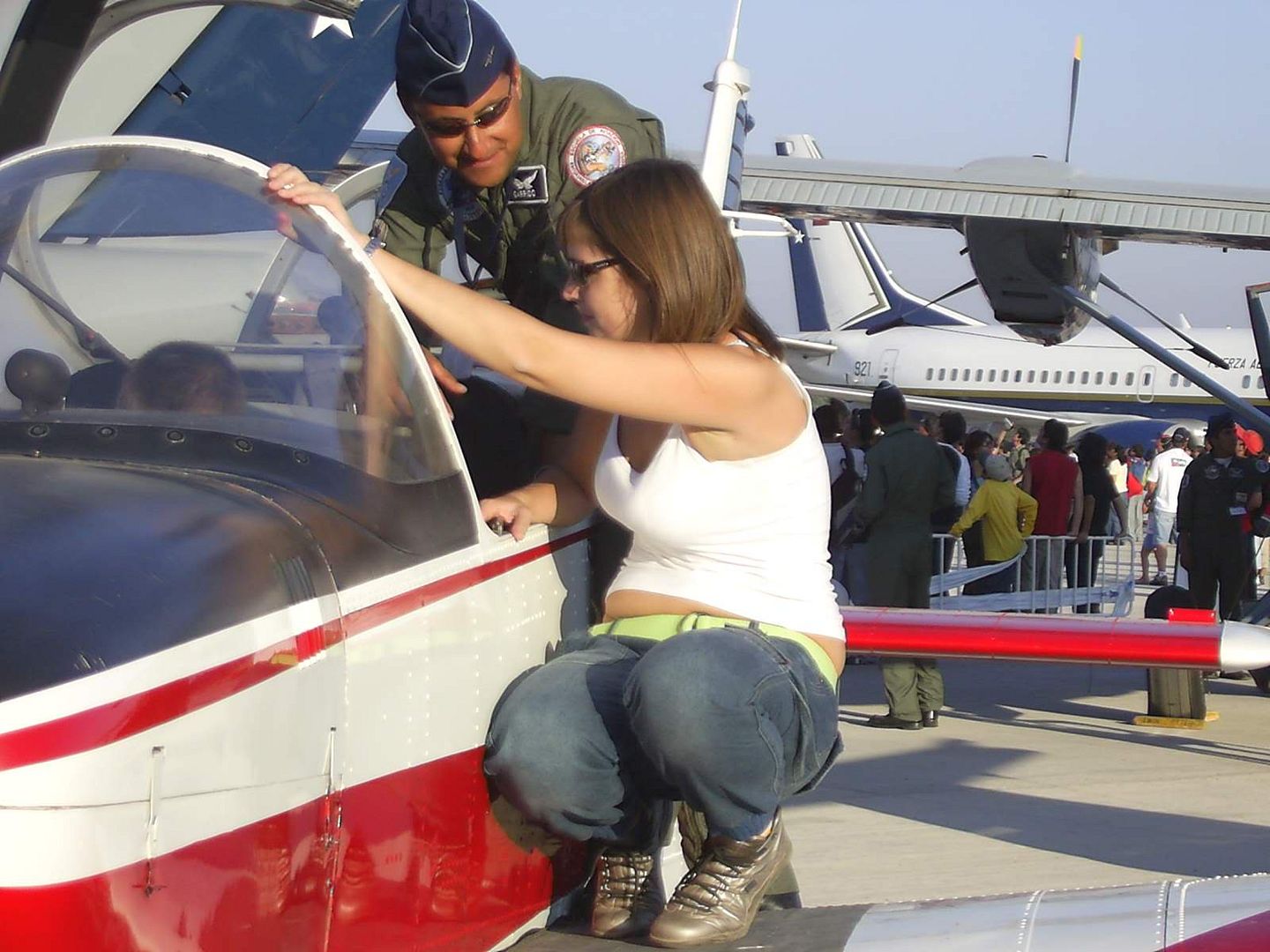
Por último ya en casa, me queda ahora la tarea de seleccionar y clasificar la enorme catidad de informativos , revistas, posters, autoadesivos, regalos..etc.
Que amablemente me regalaron los expositores.
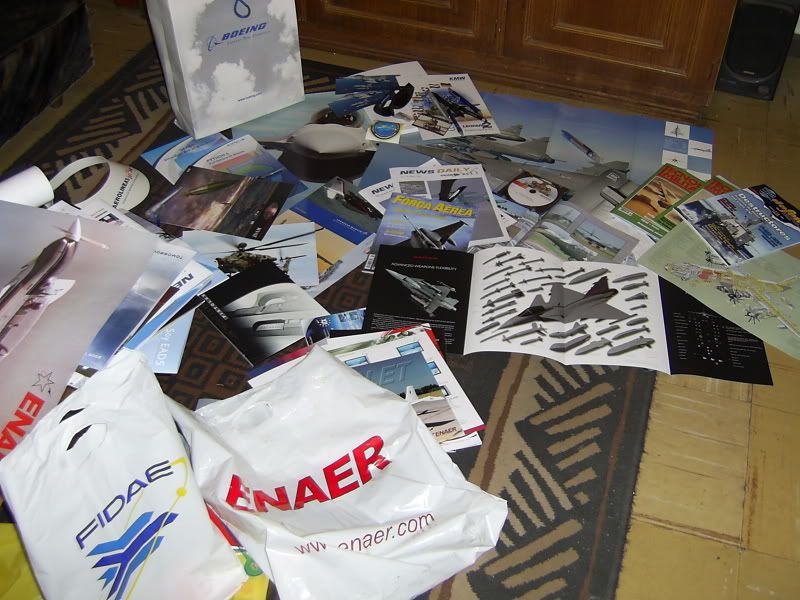
Saludos amigos.

Haré un breve reporte por ahora, pues debo revisar mas de 1500 fotografias que tomé en la semana para asi compartir con ustedes las mejores.
Les dejo algunas imagenes de hoy, dia de clausura.
El publico general repletó el recinto el dia de hoy, aqui se puede ver el interes por ver el interior de este VC-10 Tanker

El B-1B pasa a baja altura sobre nosotros.

Su tripulacion se aleja caminando del avion una vez terminado el vuelo.

Los brits se relajan ya al final de la tarde

Un Eagle terminando su espectacular demostración.

Los cuatro perros bravos de la FACH...

Hace tiempo que no veia a la ranita hacer tan buen show como lo hizo hoy, aqui se le ve regresando a la linea de vuelo tras su presentación

Un UH-1 despega llevando fotografos a mirar la feria desde arriba (yo pude conseguir el mismo vuelo la FIDAE anterior) realmente vale la pena.

Por ser dia de gran afluencia de publico, los que pusieron puestos de souvenirs estaban mas que sonrientes


El ultimo show del ultimo dia , como es costumbre, estuvo a cargo de los "Halcones" quienes una vez en tierra procedieron a la tradicional ceremonia de cambio de lider.

Las chicas lindas del dia de hoy:
Este angelito de la empresa Gildemeister...

Y esta linda dama que preguntaba algo sobre un avion


La expresion de este aviador de la FACH lo dice todo
 , mientras muestra la cabina de un T-35 Pillan a esta señorita...
, mientras muestra la cabina de un T-35 Pillan a esta señorita...
Por último ya en casa, me queda ahora la tarea de seleccionar y clasificar la enorme catidad de informativos , revistas, posters, autoadesivos, regalos..etc.
Que amablemente me regalaron los expositores.

Saludos amigos.
Teseo
Colaborador
Flankerista a muerte y todo lo que te de la gana. Pero:
It is intended that the combat aircraft will support anti-drug and anti-smuggling operations in the Gulf of Mexico
Se pretende que la aeronave de combate apoye las operaciones anti-droga y anti-contrabando en el Golfo de Méjico...
Un Su-27 o un Grippen....¿Para eso?...
It is intended that the combat aircraft will support anti-drug and anti-smuggling operations in the Gulf of Mexico
Se pretende que la aeronave de combate apoye las operaciones anti-droga y anti-contrabando en el Golfo de Méjico...
Un Su-27 o un Grippen....¿Para eso?...
Guitro01
Forista Sancionado o Expulsado
Les hago una pregunta a los amigos Chilenos. ¿No seria economicamente (hablando desde un punto de vista de costos y duracion del SdA) mas conveniente ir por otro modelo que no sea el KC-135???
A mi se me ocurre, que habiendo hecho la inversion que ha hecho la FACh en un SdA tan puntero como los F-16 0km ... tambien seria interesante dotarlo de un tanquero que los acompañe a lo largo de toda su carrera de servicio activo.
Pero bueno, es solo una opinion, aunque me gustaria oir algunas respuestas, si son tan amables.
Saludos y felicitaciones por esta excelente Feria que se hace tan "cerca" y que segun algunos amigos, cada año les sale mejor!!
A mi se me ocurre, que habiendo hecho la inversion que ha hecho la FACh en un SdA tan puntero como los F-16 0km ... tambien seria interesante dotarlo de un tanquero que los acompañe a lo largo de toda su carrera de servicio activo.
Pero bueno, es solo una opinion, aunque me gustaria oir algunas respuestas, si son tan amables.
Saludos y felicitaciones por esta excelente Feria que se hace tan "cerca" y que segun algunos amigos, cada año les sale mejor!!
Temas similares
- Respuestas
- 6
- Visitas
- 922
Z
- Respuestas
- 0
- Visitas
- 375
Z







